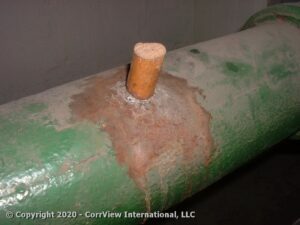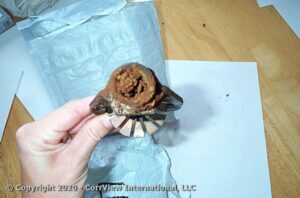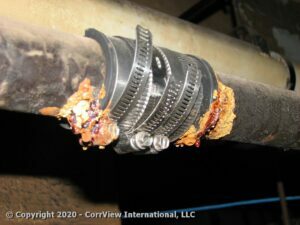Case History: CH-03
Luxury Living Disaster
| A Combination Of Neglect, Incompetence, Unknowing, And Greed Leads To Major Pipe Failure |
-
Preface
The full renovation of an old New York City warehouse produces 12 luxury condominiums selling at $10-25 million each. When completed, the water treatment contractor fails to chemically clean and passivate the pipe, and then does not begin the treatment program for more than a year. Feeding equipment and chemical drums are installed but do not function. No one managing the building recognizes the importance of the chemical treatment program, nor the damage being caused.
Following months attempting to get the chemical feed equipment to work and the program up and running, management hires a new chemical treatment company to take over this responsibility and correct past errors. After more than 16 months of no water treatment, the new company finds massive volumes of rust and mud in the open condenser water system supplying 12 individual mechanical rooms. The cooling tower and surrounding roof is covered in red rust – leading to a recommendation by the new treatment contractor that a chemical cleaning and flushing of the pipe is required prior to establishing an effective chemical treatment program.
Given the volume of the rust throughout the system, and plans to use an inhibited citric acid cleaner, the chemical treatment supplier recommends an evaluation of the piping in order to ensure that it can handle the proposed cleaning. CorrView International, LLC is secured to perform an ultrasonic investigation by the building management directly.
-
Investigation
Initial testing identifies severe corrosion and pitting activity at near 35+ mils per year (MPY). The building has a 6 in. main riser from roof level towers with individual 2-1/2 in. distribution lines to each mechanical room.
Within 2 hours we gain enough information to exclude the 2-1/2 in. threaded distribution pipe from safely being cleaned. Wall thickness has reached to near 0.140 in. from its original 0.203 in., and with a thread cut of 0.105 in., little pipe wall now remains at its most critical areas. With further investigation we find some 4 in. pipe having deep pitting which raises further concern. The 6 in. diameter pipe at the roof, pump room, and basement pump room is heavily pitted but still has sufficient wall thickness to exclude any threat due to acid cleaning. Our recommendation is to replace the 2-1/2 in. distribution lines prior to any aggressive cleaning activity.
Toward the end of our investigation the building engineer remembers an access point to the 6 in. vertical risers in one tenant space, and since we have not been able to document any riser lines, we use this opportunity to gain some very important information.
Reaching into a small 8 in. x 8 in. access hatch behind a bookcase are the main 6 in. risers. Blindly reaching around to find the pipe, we take extremely low wall thickness measurements impossibly lower compared to measurements at the risers elsewhere. Such low measurements suggest some form of error on our part, and the possibly touching the probe onto an electrical EMT conduit rather than the condenser water riser itself. A camera photo answers the question, and reveals that in fact we are correctly addressing the 6 in. condenser water risers, but that the pipe is stenciled as ASTM A135 schedule 10 fire sprinkler pipe with a Korean pipe stamp. The pipe is ERW seamed rather than seamless as called for by specification.
We perform multiple sets of measurements at as much of the pipe as is within reach and identify severely low thickness values of near 0.065 in. from its original 0.134 in. dimension. This 0.065 in. dimension is far lower than the 0.280 in. wall thickness specification for new schedule 40 steel pipe by almost 75%.
Given this finding, we then return to an area at the roof where the risers begin and have the wall opened to gain access. While the roof level pipe is all A53 seamless schedule 40 as per design specifications, it transitions to thin wall schedule 10 fire sprinkler pipe immediately upon entering the riser chase. A second area of the riser is opened above the basement pump room ceiling where another finding of thin wall schedule 10 fire pipe is made. Although all exposed pump related pipe is schedule 40, it is transitioned to thin wall schedule 10 fire sprinkler pipe as soon as it becomes hidden from sight. Although later argued in court that it was a simple stock ordering error, this pipe substitution to thinner and cheaper pipe cannot be viewed in any way other than being a deliberate effort to save on the cost of heavier schedule 40 pipe.
With such low thickness values present now at the main 6 in. risers as well as at the 2-1/2 in. distribution piping, CorrView recommends against any form of chemical cleaning. Almost two years of severe corrosion against thin wall fire sprinkler pipe now demands full pipe replacement. We warn that there is nothing that the new chemical treatment company can do to save the building without incurring great liability.
-
Conclusion
Our final report is submitted to the building engineer within 2 weeks. Given the importance of our findings, CorrView International, LLC meets with the property management team on-site to review our results.
Within 60 minutes of delivering the report, a catastrophic failure of the 6 in. main supply riser occurs at an incomplete weld seam at the schedule 10 riser pipe which has been much further weakened due to the severe corrosion. The failure occurs to another floor than was previously tested. Water floods through multiple condo units, with building engineering having to smash open the tenant walls of multi million dollar residences – first in order to find the failure, and then to apply an emergency repair clamp. Having occurred in late June during a long week of high temperatures, the entire building loses all air condition for about one day and suffers massive water damage..
The entire condenser water piping system is soon replaced. Multiple lawsuits result.
© Copyright 2023 – William P. Duncan, CorrView International, LLC





















